PHOTO CREDIT: National Archives
Omar Nelson Bradley
Timeline of General Bradley's Life
1893
On February 12, Omar Nelson Bradley was born in rural Randolph County, Missouri, nine months to the day after the wedding of his parents, John and Mary Bradley. His father was a well-respected school teacher; however, they were very poor and John Bradley took on many additional jobs and projects to provide for the family.
1908
Young Omar’s beloved father died from pneumonia. Many of the traits Bradley would become famous for can be attributed to John Bradley, including a love of reading and baseball, and his excellent marksmanship.
1910
Bradley graduated from Moberly High School. He was a standout student and athlete, serving as captain of the baseball and track and field teams. After graduating from high school, Bradley worked as a boilermaker for the Wabash Railroad. His plan was to work for a year and save enough money to study law at the nearby University of Missouri.
1911
His Sunday school teacher at Central Christian Church in Moberly encouraged Bradley to take the entrance exam for the U.S. Military Academy at West Point as the tuition was free and students received a small stipend. Bradley agreed on the condition the Wabash Railroad would allow for time off and a free commute to St. Louis.
On July 12, Bradley received a telegram informing him that he had finished second among those who took the West Point entrance exam. Because the top finisher on the exam was unable to accept the Congressional appointment, Bradley was nominated to the academy.
On August 1, Bradley reported to the U.S. Military Academy as one of 164 cadets. This class would become known as “The Class the Stars Fell On” because of the extraordinary number of generals it produced. Bradley, notably, was the first general officer of his class.

PHOTO CREDIT: West Point Museum
1914
A standout athlete, Bradley earned letters in both football and baseball and turned down offers to play professional baseball to honor his Army commitment. He took pride in the fact that all of the 1914 baseball team who stayed in the Army would become generals. Bradley would later comment on the importance of sports in teaching the art of group cooperation.

PHOTO CREDIT: The Howitzer: The Yearbook of the United States Corps of Cadets, 1915, page 278
1915
Bradley graduated from the U.S. Military Academy on June 12, ranking 44th academically in his class.
Bradley was commissioned as a Second Lieutenant and assigned to the 14th Infantry Regiment at Fort George Wright, near Spokane, Washington. Bradley and the 14th Infantry Regiment served under General John J. Pershing, another Missouri native, along the U.S.-Mexico border.
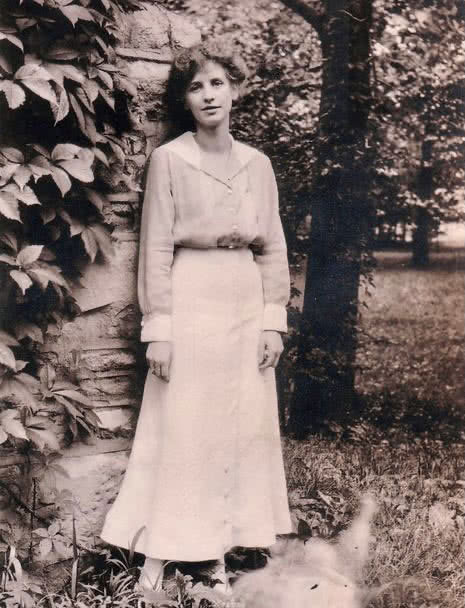
PHOTO CREDIT: Find a Grave
1916
Bradley married Mary Quayle, his childhood neighbor in Moberly. Bradley and his wife attended Central Christian Church and Moberly High School together. She earned a college degree in education. Mary Quayle Bradley died in 1965.
1917
In April, Bradley was promoted to Captain and was in command of the second battalion of the 14th Infantry, which was sent to guard the copper mines in South Dakota during World War I.
1919
In September, Bradley began a one-year stint as an assistant professor of military science at South Dakota State in Brookings, S.D. Like his father, Bradley had started his teaching career.
1920
Bradley returned to the U.S. Military Academy, where he taught mathematics for four years.
1924
Bradley was promoted to Major, and following an assignment to Hawaii, he was selected to attend the U.S. Army Command and General Staff School at Fort Leavenworth, Kansas.
1927
Appointed officer in charge of National Guard affairs, becoming the liaison officer between the U.S. Army and the Hawaiian National Guard.
1929
The Army presented Bradley with a choice: to serve as treasurer at the U.S. Military Academy in West Point or become an instructor at the infantry school in Fort Benning, Georgia, under Lieutenant Colonel George C. Marshall. He chose to become an instructor at Fort Benning, later calling it “the most fortunate decision of my life.”
1934
Bradley graduated from the Army War College and returned to West Point to serve in the Tactical Department.

PHOTO CREDIT: U.S. Army Center of Military History
1936
Bradley was promoted to Lieutenant Colonel on June 22 and began working for the War Department.
1938
Bradley reported for duty on the War Department General Staff in Washington DC. He began reporting to Marshall, who had become the U.S. Army Chief of Staff.
1941
In February, the Army was expanding in anticipation of war. Marshall, now Army Chief of Staff, promoted Bradley from Lieutenant Colonel to Brigadier General skipping the rank of Colonel. He returned to Fort Benning, Georgia, as the commander of the U.S. Army Infantry School. Bradley’s model of an officer candidate school was so successful that it was replicated throughout the country. It is still considered his most important contribution to the Army.
Bradley assisted in the Louisiana Maneuvers, a series of exercises designed to evaluate training, logistics, doctrine, and commanders that included more than 400,000 troops.
1942
Bradley was recognized as a top trainer of infantrymen and promoted to Major General. He took command of the 28th Infantry Division and the 82nd Infantry Division. There, he oversaw parachute training and the formation of the Army’s first airborne division.
1943
On his 50th birthday, Bradley received the following telegram from George Marshall: “It is only fitting that your birthday should precede by only a few days your transfer to command a corps, which comes as a long-delayed acknowledgment of your splendid record with the 28th division. Congratulations and best wishes.”
Bradley recommended a complete reorganization of II Corps after it was soundly defeated by the Germans at the Battle of Kasserine Pass. As the head of the II Corps for the North African campaign, under General George S. Patton, Bradley captured Bizerte, Tunisia. This victory contributed directly to the fall of Tunisia and the surrender of more than 250,000 Axis troops. He then went on to successfully command his forces during the invasion and conquest of Sicily in August.
On September 10, Bradley was transferred to London as Commander in Chief of the American ground forces preparing to invade France in the spring during World War II.



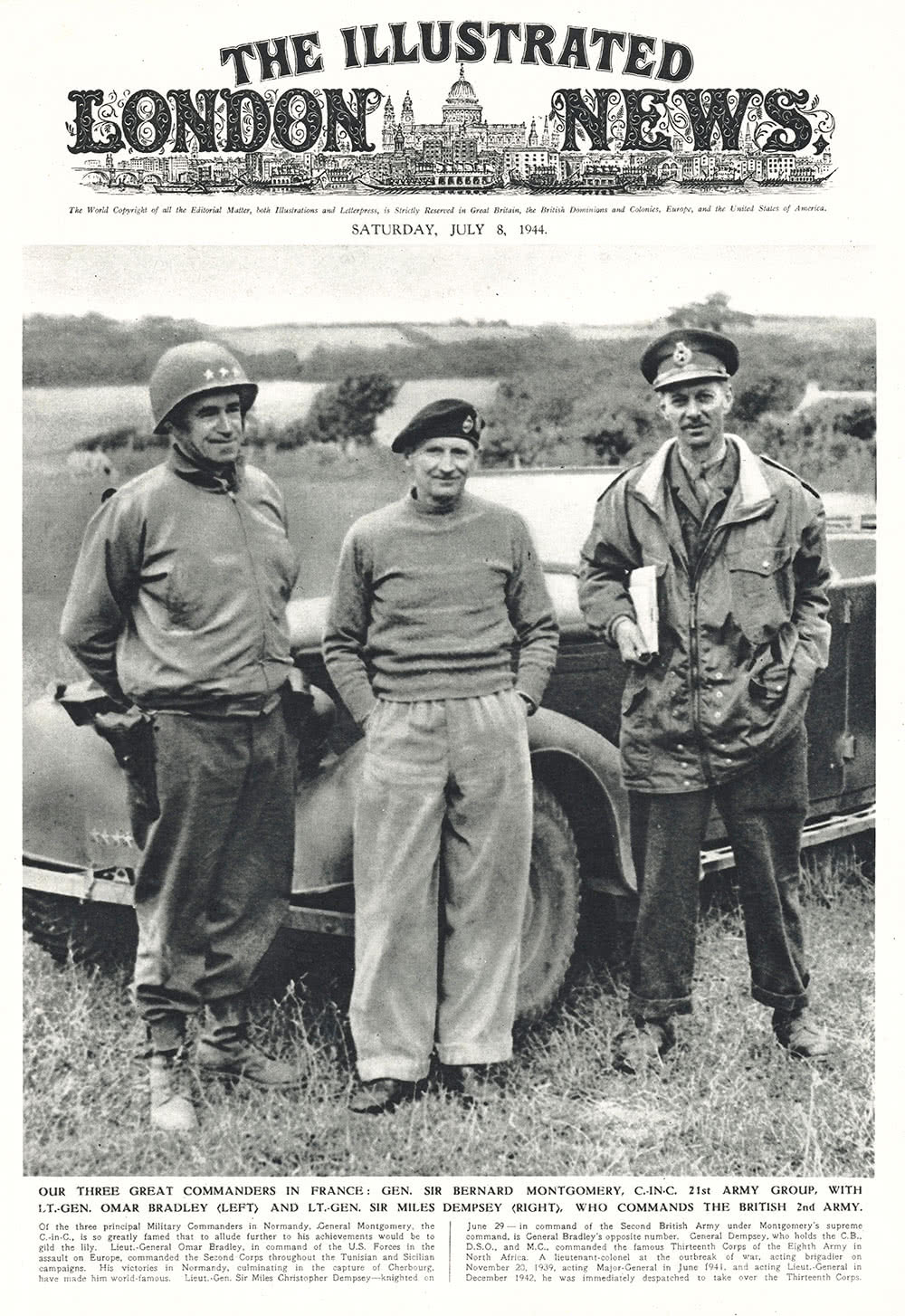
1944
During the early stages of World War II, Germany's triumph over France was followed by strategic initiatives between the United States and Britain to liberate France from German occupation. Codenamed "Overlord," Operation Overlord aimed to deploy Allied forces onto the shores of northern France, particularly Normandy, with designated code names for the landing beaches: Gold, Sword, Juno, Utah, and Omaha.
Supreme Allied Commander General Dwight D. Eisenhower, overseeing Allied forces, meticulously planned the invasion. He appointed General Omar Bradley to lead American forces. The pivotal day of the operation, known as "D-Day," was shrouded in secrecy.
Operation Overlord's execution on June 6, 1944, resulted in significant casualties among Allied forces, with Omaha Beach witnessing the deadliest combat. Through relentless Allied advances, the Nazi military retreated to Germany's borders.
In August, he was elevated to command of the U.S. Twelfth Army Group. Under his leadership the First, Third, Ninth, and Fifteenth armies successfully carried on operations in France, Luxembourg, Belgium, the Netherlands, Germany, and Czechoslovakia until the end of European hostilities.
1945
On March 29, Bradley was promoted to General.
On August 15, President Truman selected Bradley to lead the Veterans Administration (VA). Bradley completely rebuilt the organization on a regional basis. Always the “Soldier’s General,” Bradley insisted on basing his decisions on the needs of the veteran, rather than on the political considerations. He revised and extended the educational benefits of the G.I. Bill - arranged for jobs and job training programs, established a program of loans for veterans, and administered a staggering growth in veterans insurance and disability pensions.

PHOTO CREDIT: Library of Congress

By the end of the war in Europe, Bradley commanded forty-three divisions and 1.3 million men, the largest force of American soldiers to serve under a US field commander.
1947
General Bradley was featured in the Infantry Journal in December.
1948
On February 7, Bradley succeeded Eisenhower as Army Chief of Staff.
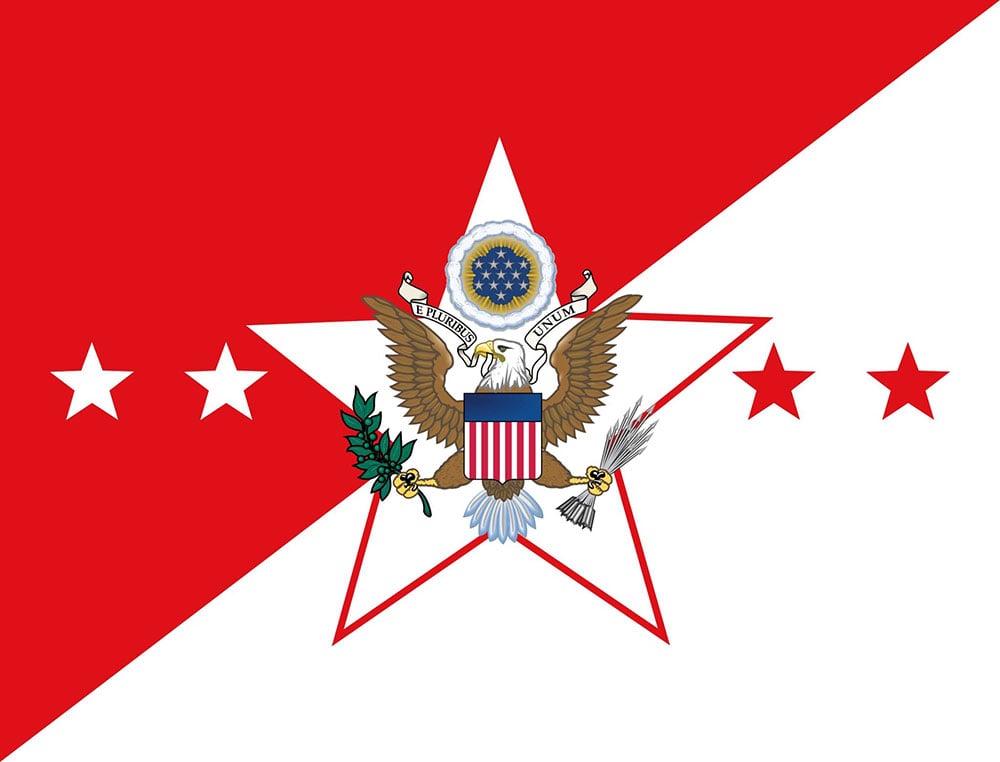
PHOTO CREDIT: U.S. Army Europe and Africa
1949
On August 16, Bradley made history by becoming the first Chairman of the Joint Chiefs of Staff thanks to his exemplary service and expertise. As Chairman, Bradley was the senior military officer at the outset of the Korean War. His leadership during the Korean War was characterized by his keen strategic insight, pragmatic approach, and commitment to achieving the goals set forth by the United Nations and the U.S. government.

PHOTO CREDIT: SAAM
1950
Joseph E. Renier designed the Omar N. Bradley Medal Distinguished Service Award.
On September 22, the 81st Congress officially promoted Bradley to General of the Army with five stars. He was the last officer in the American defense establishment to be promoted to that rank, and the only one since World War II.

1951
In May, Bradley testified before the Senate Committee on Armed Services and Foreign Relations arguing against extending the Korean War into China. His rebuke, “Frankly, in the opinion of the Joint Chiefs of Staff, this strategy would involve us in the wrong war, at the wrong place, at the wrong time, and with the wrong enemy,” would go on to be repeated by many presidents about other conflicts.
Bradley’s memoir A Soldier’s Story was published.
1953
After retiring from the army in 1953, Bradley was active in private enterprise and remained a prominent figure in American culture.
Bradley maintained close ties to Missouri. He visited often and affectionately called Moberly his favorite city in the world. He actively participated in the community as a member of the Moberly Rotary Club and enjoyed frequent rounds of golf at Moberly Country Club.
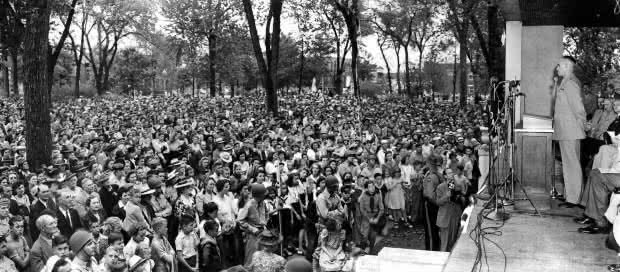
PHOTO CREDIT: St. Louis Post Dispatch
Omar Bradley speaking in Moberly, MO.
1958
Bradley served as the chairman of the board of the Bulova Watch Company, a position he held until 1973.

PHOTO CREDIT: National Archives
1966
Married Esther Dora Buhler.
1968
Bradley was one of the "wise men" who reviewed Vietnam policy for President Lyndon B. Johnson.

PHOTO CREDIT: National Archives
1969
25 Years after D-day Bradley visits Omaha Beach.
1970
Bradley served as an adviser to the Academy Award-winning movie, “Patton.”

1971
Bradley began writing his autobiography. After several attempts, the project was set aside. Author Clay Blair reinvigorated the project with Bradley’s blessing and assistance in 1979. Ultimately, A General’s Life was published in 1983, after Bradley’s death.
1974
General Bradley attended the commemoration of the 30th Anniversary of D-Day in Normandy.
1977
On January 10, President Gerald Ford awarded Bradley the Presidential Medal of Freedom, the highest civilian honor the United States can bestow. Bradley was described as: “Military hero, courageous in battle, and gentle in spirit, friend of the common soldier, General of the Army, first Chairman of the Joint Chiefs of Staff, he embodies the best of the American military tradition with dignity, humanity, and honor."
1978
Bradley was honored with the Golden Plate Award by the American Academy of Achievement, presented by General Jimmy Doolittle.
1979
General Bradley was the keynote speaker for the 35th Anniversary commemoration of D-Day in Normandy.
1981
In January, General Bradley appeared as a special guest at the Inauguration of President Ronald Reagan.

The M2 Bradley Fighting Vehicle, named after General Omar Bradley, entered service in 1981 and is still in service today. This infantry fighting vehicle carries a crew of three and a six-man infantry squad that can dismount for combat operations.

On April 8, Bradley died of cardiac arrhythmia in New York City. He is buried in Arlington National Cemetery.
Bradley served on active duty continuously from his arrival at West Point on August 1, 1911, until his death on April 8, 1981; a total of 69 years, 8 months and 7 days.
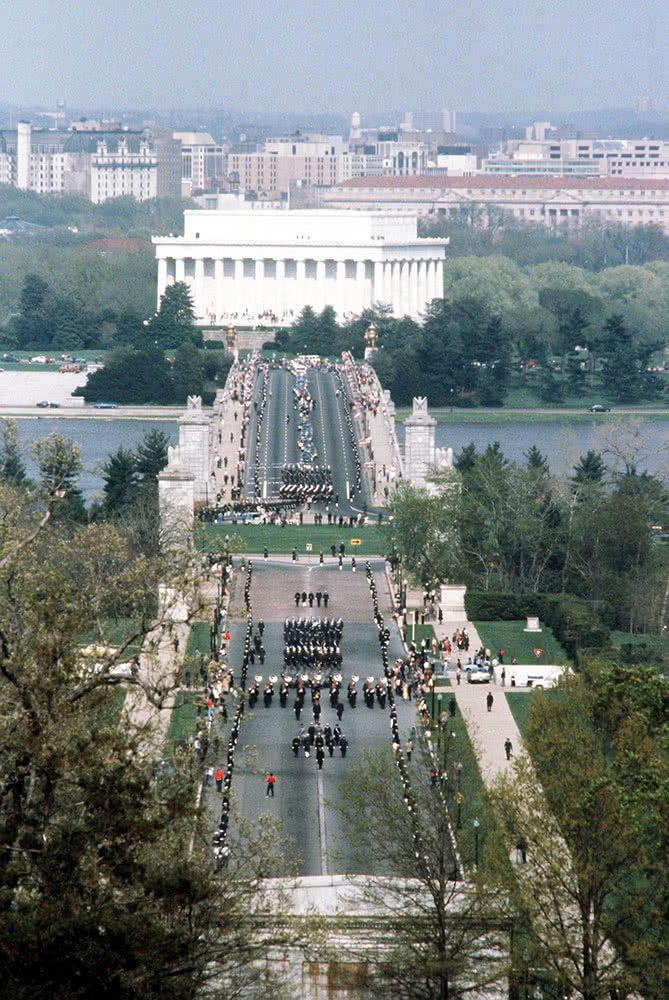
His was the longest active duty career in the history of the United States Armed Forces.
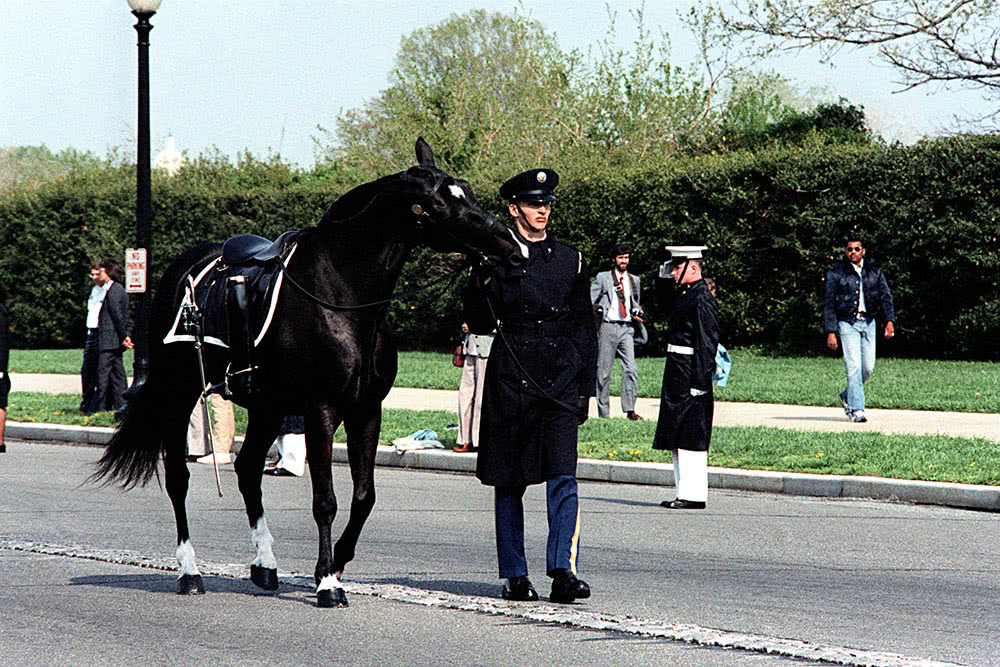
PHOTO CREDIT: National Archives
A riderless horse and his handler walk behind the caisson carrying the body of retired five-star General Omar N. Bradley, during his funeral procession.

1991
Moberly citizens formed a committee to establish a War Memorial in Rothwell Park, funded entirely by contributions from both local sources and every state in the U.S. This effort was supported by veterans, their families, veteran organizations, the Moberly City Park, businesses, industries, and the City of Moberly.
1996
The statue of General Omar Bradley is erected at the War Memorial in Rothwell Park. The memorial honors General Omar Bradley, known as the "GI's General," as well as veterans everywhere. It serves as a lasting reminder of General Bradley's superb leadership and the significant sacrifices made by him and the troops during World War II to preserve cherished freedoms.
2000
In 2000, the Postal Service released four 33-cent Distinguished Soldiers commemorative stamps in Washington, DC, which were available nationwide the same day. Designed by Phil Jordan from Falls Church, Virginia, the stamps feature black-and-white photographs of Alvin C. York, John L. Hines, Audie L. Murphy, and Omar N. Bradley. These stamps honor the soldiers for their heroism and leadership during World War I and World War II.

PHOTO CREDIT: Smithsonian

PHOTO CREDIT: National Archives
For Further Study
-
State Historical Society of Missouri
-
Join Chiefs of Staff
-
The Washington Post on February 6, 1983
-
U.S. Army Center of Military History
-
U.S. Department of Veterans Affairs
-
History Channel
-
Britannica




